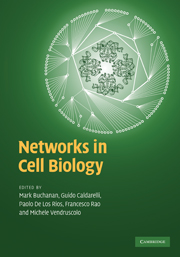Book contents
- Frontmatter
- Contents
- List of contributors
- Introduction
- 1 Network views of the cell
- 2 Transcriptional regulatory networks
- 3 Transcription factors and gene regulatory networks
- 4 Experimental methods for protein interaction identification
- 5 Modeling protein interaction networks
- 6 Dynamics and evolution of metabolic networks
- 7 Hierarchical modularity in biological networks: the case of metabolic networks
- 8 Signalling networks
- Appendix A Complex networks: from local to global properties
- Appendix B Modelling the local structure of networks
- Appendix C Higher-order topological properties
- Appendix D Elementary mathematical concepts
- References
- Index
4 - Experimental methods for protein interaction identification
Published online by Cambridge University Press: 05 June 2012
- Frontmatter
- Contents
- List of contributors
- Introduction
- 1 Network views of the cell
- 2 Transcriptional regulatory networks
- 3 Transcription factors and gene regulatory networks
- 4 Experimental methods for protein interaction identification
- 5 Modeling protein interaction networks
- 6 Dynamics and evolution of metabolic networks
- 7 Hierarchical modularity in biological networks: the case of metabolic networks
- 8 Signalling networks
- Appendix A Complex networks: from local to global properties
- Appendix B Modelling the local structure of networks
- Appendix C Higher-order topological properties
- Appendix D Elementary mathematical concepts
- References
- Index
Summary
Introduction
Protein interactions can be identified by a multitude of experimental methods. In fact, the IntAct database of molecular interactions currently lists about 170 different experimental methods and variations thereof that can be used to detect and characterize protein–protein interactions (the main classes are listed in Table 4.1). While we present the commonly used methods in this chapter we will focus on the few technologies which are used in high-throughput studies and thus generated the vast majority of interaction data available today: the yeast two-hybrid (Y2H) assay and protein complex purification and identification by mass spectrometry (MS) (Table 4.2). These two methods represent two fundamentally different sources of interaction data and thus it is important to understand how they work and what strengths and weaknesses each of them has. This is especially important for theoretical analyses which often draw conclusions from datasets which may not be adequate for certain studies. For example, membrane proteins are underrepresented in both yeast two-hybrid and complex purification studies.
Complex versus binary interactions
It is important to note that most methods detect either direct binary interactions or indirect interactions without knowing which proteins are interacting. The yeast two-hybrid system usually detects direct binary interactions while complex purification detects the components of complexes (Fig. 4.1). Complex data are often interpreted as if the proteins that co-purify are interacting in a particular manner, consistent with either a spoke or matrix model.
- Type
- Chapter
- Information
- Networks in Cell Biology , pp. 53 - 82Publisher: Cambridge University PressPrint publication year: 2010



